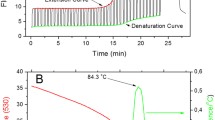Abstract
Several techniques have been developed for detection and quantification of genetically modified organisms, but quantitative real-time PCR is by far the most popular approach. Among the most commonly used real-time PCR chemistries are TaqMan probes and SYBR green, but many other detection chemistries have also been developed. Because their performance has never been compared systematically, here we present an extensive evaluation of some promising chemistries: sequence-unspecific DNA labeling dyes (SYBR green), primer-based technologies (AmpliFluor, Plexor, Lux primers), and techniques involving double-labeled probes, comprising hybridization (molecular beacon) and hydrolysis (TaqMan, CPT, LNA, and MGB) probes, based on recently published experimental data. For each of the detection chemistries assays were included targeting selected loci. Real-time PCR chemistries were subsequently compared for their efficiency in PCR amplification and limits of detection and quantification. The overall applicability of the chemistries was evaluated, adding practicability and cost issues to the performance characteristics. None of the chemistries seemed to be significantly better than any other, but certain features favor LNA and MGB technology as good alternatives to TaqMan in quantification assays. SYBR green and molecular beacon assays can perform equally well but may need more optimization prior to use.

Similar content being viewed by others
References
Gruere GP, Rao SR (2007) AgBioForum 10:51–64
James C (2009) Global status of commercialized biotech/GM crops 2008. ISAAA brief 39, 1–20. Ithaca, NY
Holst-Jensen A, Ronning SB, Lovseth A, Berdal KG (2003) Analytical and Bioanalytical Chemistry 375:985–993
Holst-Jensen A (2007) Sampling, detection, identification and quantification of genetically modified organisms (GMOs). In: Food Toxicants Analysis. Techniques, Strategies and Developments. Elsevier, Amsterdam, Netherlands
Gene Quantification [http://gene-quantification.info/]. 24-7-2009
Bustin SA (2005) Expert Rev Mol Diagn 5:493–498
Hernandez M, Esteve T, Prat S, Pla M (2004) J Cereal Sci 39:99–107
Terry CF, Shanahan DJ, Ballam LD, Harris N, McDowell DG, Parkes HC (2002) J AOAC Int 85:938–944
Andersen CB, Holst-Jensen A, Berdal KG, Thorstensen T, Tengs T (2006) J Agric Food Chem 54:9658–9663
Buh GM, Cankar K, Zel J, Gruden K (2008) BMC Biotechnol 8:26
La Paz JL, Esteve T, Pla M (2007) J Agric Food Chem 55:4312–4318
Higuchi R, Fockler C, Dollinger G (1993) Watson R. Biotechnology (NY) 11:1026–1030
Schneeberger C, Speiser P, Kury F, Zeillinger R (1995) PCR Methods Appl 4:234–238
Ririe KM, Rasmussen RP, Wittwer CT (1997) Anal Biochem 245:154–160
Giglio S, Monis PT, Saint CP (2003) Nucleic Acids Res 31:e136
Karsai A, Muller S, Platz S, Hauser MT (2002) Biotechniques 32:790–796
Zipper H, Brunner H, Bernhagen J, Vitzthum F (2004) Nucleic Acids Res 32:e103
Nazarenko I, Pires R, Lowe B, Obaidy M, Rashtchian A (2002) Nucleic Acids Res 30:2089–2195
Sherrill CB, Marshall DJ, Moser MJ, Larsen CA, Daude-Snow L, Jurczyk S, Shapiro G, Prudent JR (2004) J Am Chem Soc 126:4550–4556
Nazarenko IA, Bhatnagar SK, Hohman RJ (1997) Nucleic Acids Res 25:2516–2521
Holland PM, Abramson RD, Watson R, Gelfand DH (1991) Proc Natl Acad Sci USA 88:7276–7280
Kutyavin IV, Afonina IA, Mills A, Gorn VV, Lukhtanov EA, Belousov ES, Singer MJ, Walburger DK, Lokhov SG, Gall AA, Dempcy R, Reed MW, Meyer RB, Hedgpeth J (2000) Nucleic Acids Res 28:655–661
Costa JM, Ernault P, Olivi M, Gaillon T, Arar K (2004) Clin Biochem 37:930–932
Koshkin AA, Singh SK, Nielsen P, Rajwanshi VK, Kumar R, Meldgaard M, Olsen CE, Wengel J (1998) Tetrahedron 54:3607–3630
Duck P, Varado-Urbina G, Burdick B, Collier B (1990) Biotechniques 9:142–148
Tyagi S, Kramer FR (1996) Nat Biotechnol 14:303–308
European Network of GMO Laboratories (ENGL). Definition of Minimum Performance Requirements for Analytical Methods of GMO Testing (2008). http://gmo-crl.jrc.ec.europa.eu/ 2009
Santangelo P, Nitin N, Bao G (2006) Ann Biomed Eng 34:39–50
Mao F, Leung WY, Xin X (2007) BMC Biotechnol 7:76
Monis PT, Giglio S, Saint CP (2005) Anal Biochem 340:24–34
AlleLogic Biosciences Corp [http://www.allelogic.com/]. 1-8-2009
Christensen UB (2008) Methods Mol Biol 429:137–160
ISO 21569:2005. Foodstuffs—Methods of analysis for the detection of genetically modified organisms and derived products—Qualitative nucleic acid based methods. 1–69. 20-6-2005. Geneva, Switzerland; 2005
Pfaffl MW (2001) Nucleic Acids Res 29:e45
ISO 24276:2006. Foodstuffs—Methods of analysis for the detection of genetically modified organisms and derived products—General requirements and definitions. 1–16. 20-6-2005. Geneva, Switzerland; 2005
Berdal KG, Holst-Jensen A (2001) Eur Food Res Technol 213:432–438
Hernandez M, Pla M, Esteve T, Prat S, Puigdomenech P, Ferrando A (2003) Transgenic Res 12:179–189
Acknowledgment
This study was financially supported by the European Commission through the Integrated Project Co-Extra, Contract No. 007158, under the 6th framework programme, priority 5, food quality and safety and Slovenian research agency programme Plant biotechnology and systems biology P4-0165. For help with graphical illustrations we kindly thank Damijan Gašparič, MArch.
Author information
Authors and Affiliations
Corresponding author
Electronic supplementary material
Below is the link to the electronic supplementary material.
ESM 1
(PDF 515 kb)
Rights and permissions
About this article
Cite this article
Buh Gašparič, M., Tengs, T., La Paz, J.L. et al. Comparison of nine different real-time PCR chemistries for qualitative and quantitative applications in GMO detection. Anal Bioanal Chem 396, 2023–2029 (2010). https://doi.org/10.1007/s00216-009-3418-0
Received:
Revised:
Accepted:
Published:
Issue Date:
DOI: https://doi.org/10.1007/s00216-009-3418-0




